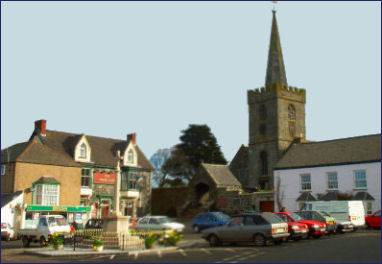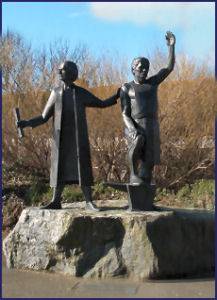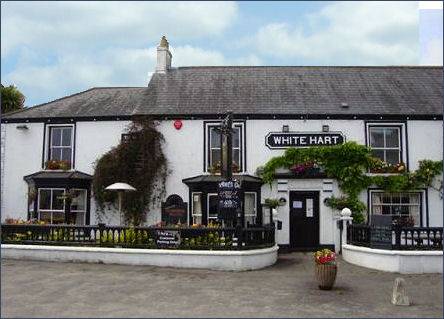St. Keverne
OS Grid ref:- SW7921
 The characterful and historic Cornish village of St. Keverne, known in Cornish as Lannaghevran, lies on the eastern side of the Lizard Peninsula
The characterful and historic Cornish village of St. Keverne, known in Cornish as Lannaghevran, lies on the eastern side of the Lizard Peninsula
St. Keverne is an ancient village which is mentioned in the Domesday Survey of 1089. Once the haunt of smugglers, St. Keverne clusters around its central village square, which contains several shops, cottages and twp pubs , the White Hart, the 1764 birthplace of Charles Incledon, a favourite Covent Garden singer of King George III, and the Three Tuns, which acquires its name from the three barrels of contrabrand brandy found in the vicar's possession in 1467. The pub provides accommodation and good food.
The bronze statues by the roadside at the entrance to the village (pictured below - right) commemorate the most impoortant event in its history, the Cornish Rebellion led by local blacksmith, Michael Joseph An Gof against the first Tudor monarch, King Henry VII, in May 1497. The king had imposed large taxes to raise money for a war against Scotland, who supported the Yorkist pretender to the throne, Perkin Warbeck. The tax was particularly unpopular amongst the Cornishmen, to whom Scotland seemed a long way away. Michael Joseph joined his forces with those of Thomas Flamank, a Bodmin landowner's son. Armed only with with staves, pitchforks and homemade weapons, the rebels, gathering supporters on the way, confronted the Royal army at Blackheath. The rising however was put down with severity and Flamank and Michael Joseph, after a period of imprisonment in the Tower of London, suffered the barbarous traitor's death of being hung, drawn and quartered. In 1997, celebrations, including a march to London, were held to commemorate the five hundredth anniversary of the rebellion.
 During the reign of the boy king Edward VI, 8 Cornishmen were taken at gunpoint to Launceston Castle in 1548, where they were hung, drawn and quartered. Resentment had been building up in Cornwall ever since the 1530s, when Henry VIII broke from Rome and established the Church of England. Henry VIII had already put down a huge uprising in the north of Cornwall in 1536 and during the reign of his son Edward VI discontent at the religious changes was rife. The people of St Keverne learnt that William Body, the archdeacon of Cornwall, had begun removing images from the church in Helston. St. Keverne lay in what was once the heartland of Cornish-speaking west Cornwall. Led by their parish priest, Martin Geffrey, they set off for Helston, joined by many along the way.
Body sought refuge rom the mob in a nearby house but was dragged out by the crowd and murdered. Retribution was swift and brutal. The mob, which had swelled to around 3,000 people, was dispersed by the arrival of Sir William Godolphin and other justices of the peace, and eight of the Cornishmen were taken to Launceston for execution.
During the reign of the boy king Edward VI, 8 Cornishmen were taken at gunpoint to Launceston Castle in 1548, where they were hung, drawn and quartered. Resentment had been building up in Cornwall ever since the 1530s, when Henry VIII broke from Rome and established the Church of England. Henry VIII had already put down a huge uprising in the north of Cornwall in 1536 and during the reign of his son Edward VI discontent at the religious changes was rife. The people of St Keverne learnt that William Body, the archdeacon of Cornwall, had begun removing images from the church in Helston. St. Keverne lay in what was once the heartland of Cornish-speaking west Cornwall. Led by their parish priest, Martin Geffrey, they set off for Helston, joined by many along the way.
Body sought refuge rom the mob in a nearby house but was dragged out by the crowd and murdered. Retribution was swift and brutal. The mob, which had swelled to around 3,000 people, was dispersed by the arrival of Sir William Godolphin and other justices of the peace, and eight of the Cornishmen were taken to Launceston for execution.
 Cornwall was staunchly Roylaist during the Civil War and supported the cause of King Charles I, Launceston Castle, however, had declined to such a poor state of repair that the Parliamentarian army did not bother to damage it further when they gained control from the supporters of the king.
Cornwall was staunchly Roylaist during the Civil War and supported the cause of King Charles I, Launceston Castle, however, had declined to such a poor state of repair that the Parliamentarian army did not bother to damage it further when they gained control from the supporters of the king.
St. Keverne's Church, St. Akeveranus, is one of the largest parish churches in Cornwall, the obscure St. Keiran, a Celtic monk, erected a small wooden church on the site of the present church in around AD 600. The more permanent Saxon building which followed Keiran's church was known as a Collegiate Church and was a centre of learning, study and education, but the building was destroyed by the Normans some time before 1085. The present building dates to the fifteenth century, the tower and spire were constructed around 1450, the spire was destroyed by lightening on 28th February 1770, but was almost immediately rebuilt. The tower is of two stages and rises to sixty feet high, it is surmounted by an octagonal ribbed spire of about thirty eight feet.
The interior boasts an impressive wagon roof, elaborately carved bench ends and a mural of St Christopher, patron saint of travellers, which was discovered under whitewash in 1839. The grey, green and rose coloured stone used in the pillars cannot be found locally and is thought to have originated from Brittany. Behind the Altar is the Mohegan Memorial Window, a stained glass window which was erected by the owners of the SS Mohegan after the ship was wrecked on the Manacles in 1898. There is also a memorial to a victim of the Titanic. From the top of the battlemented tower, which serves as a landmark for shipping, it is possible to see Brown Willy, the highest point on Bodmin Moor.
The Ox Roast is held in the village every year in August. The ceremony originates from the Coronation of George VI in 1937. In 1953 when meat rationing was still in force the Ministry of Food issued orders that communities could only celebrate with a roasting if they could show they had cooked an ox for the late King.
The nearby treacherous Manacle Rocks, located around a mile from the shoreline, have claimed many ships mainly due to the fact that the rocks are submerged at high tide. The most famous ship lost was the SS Mohegan which was wrecked on the notorious rocks in 1898 with the loss of 106 lives, a monument to the disaster stands in the churchyard. The rocks derive their name from the old Cornish "Maen Eglos", meaning Church Rocks.